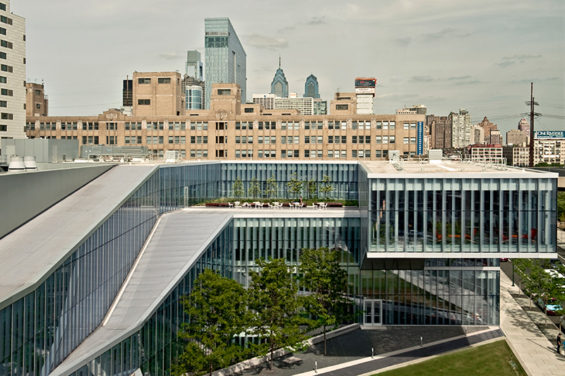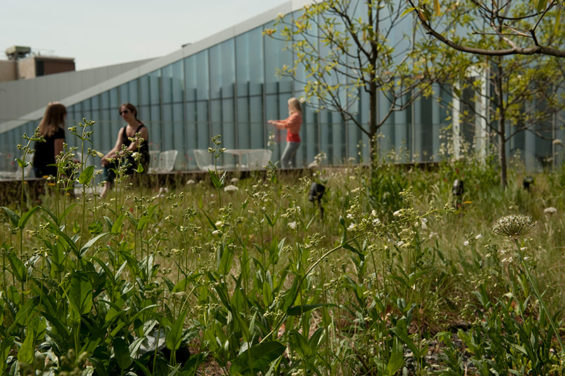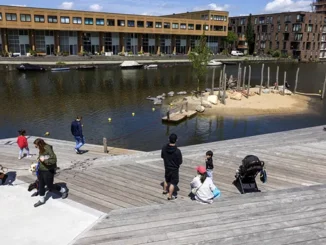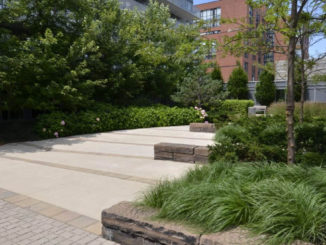Krisha P. Singh Center for Nanotechnology includes two green roof areas. The Meadow Roof is a prominent feature of the building attracting individuals and groups eager to enjoy time in the rooftop amenity space. A second larger Sedum Roof includes native perennials and grasses planted alongside the building’s air handling and HVAC equipment. This larger Sedum Roof may have less aesthetic and cultural significance; however, it is a storm water management workhorse. Both green roof areas are an integral part of the project’s stormwater management plan. Surrounded by floor to ceiling etched glass walls on three sides and a clear glass railing open to the city on the fourth side, the Meadow Roof is visually accessible from corridors and conference rooms.
Established in 1740 by Benjamin Franklin, the University of Pennsylvania campus is home to many significant buildings designed by prominent architects including Cope and Stewardson, Frank Furness and Louis Kahn. The Singh Center, completed two years ago, will likely be considered one the University’s great buildings. The building is important architecturally and, as the University’s first cross disciplinary building, it also alters the way research is conducted by encouraging collaboration between the School of Engineering and Applied Sciences and the School of Arts and Sciences. Beyond the confines of the University, the building is open to all academic and industry institutions working in relevant fields and the Meadow Roof is accessible to all who have access to the building. The Meadow Roof is a popular destination for students and scholars tourists. They stop, linger, and often take photos of their friends, themselves, and the Meadow Roof – catching spectacular blooms from the diverse suite of native plants that knit together to form this rooftop garden. Attracted by the regional plant community, Monarchs dip in; Mockingbirds dart out, and Honey Bees linger to gather nectar and pollen.
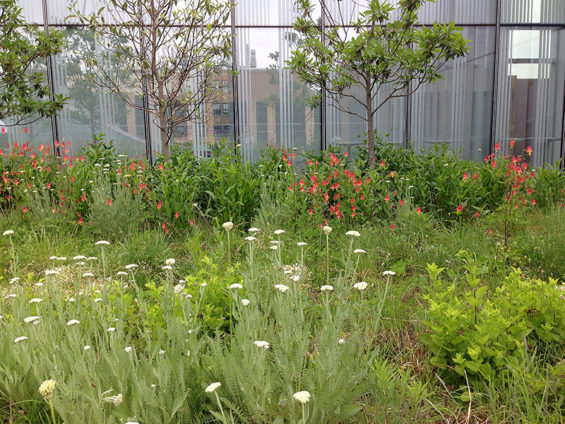
Both green roof areas feature a diversity of planting that includes a number of native species that attract a variety of birds and pollinators. Over time, the Sedum Roof is expected to become increasingly diverse. During the first year after planting annuals (Gaillardia pulchella) germinated among the pre-grown Sedum mats. In the second growing season, the annuals emerged again, this time along with biennials and young perennials (Echinacea pallida). The young perennials emerged as immature rosettes. This year, during the third growing season, grasses (Schizachyrium scoparium) and perennials are reaching mature heights. With appropriate maintenance and annual overseeding, we expect increasing biodiversity over the next four to seven growing seasons, until the native perennials and grasses overtake the Sedum and Phedimus cover as the dominate plant types.
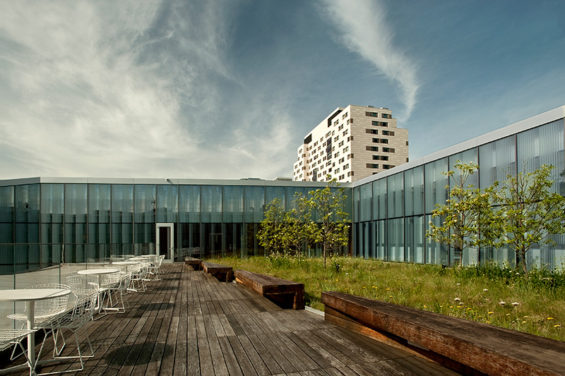
The exuberant balance of soft materials and hardscape including ipe benches and decking, light white metal tables and chairs, etched glass walls, a clear glass railing, and views of paintings and prints hanging on the solid interior walls create an intricate background for the stage of the colorful, highly textural plantings. The color orange is used as a unifying theme throughout the building, and the green roof is no exception. Perennials that bloom in shades of orange, coral and yellow signify solidarity with the saffron color palette. In the fall, the buff seed heads of the warm season grasses loosely harmonize with the limited palette.
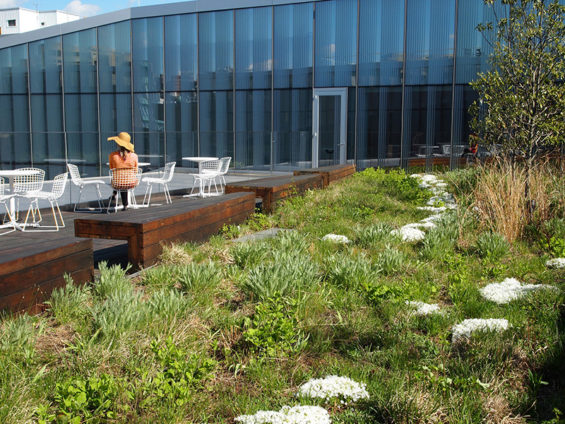
From the sidewalk one can experience the etched glass curtain wall and interior orange tinted windows emitting a vibrant glow. Visible from the exterior of the building, the Meadow Roof serves to insert a slice of the natural world within this highly designed setting. The controlled naturalism of the Meadow Roof springs up from the layers of the intersecting planes of the curtain wall. The vertical stems of the trees echo the verticals of the etched glass curtain wall.
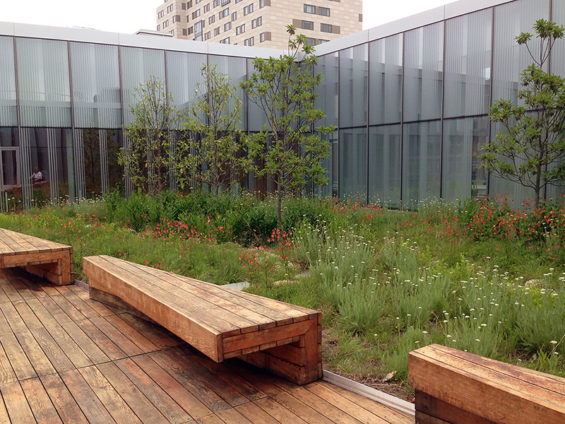
For all non-residential properties, Philadelphia imposes a monthly Stormwater Management Service fee that correlates with the parcel’s impervious surface area. Acknowledged as pervious cover, green roofs contribute to a credit against the City’s Stormwater fee. In addition to managing the rainfall on the planted areas, these green roofs also manage runoff from 4,460 sf of impervious tributary areas. The City recognizes these tributary areas as pervious for the purpose of stormwater fee credit calculations. As a result of this design that optimizes stormwater performance, these green roofs reduced the University’s stormwater fee for this site by 27%. The green roofs also play a prominent role in the site stormwater management strategy, assuring cost-effective compliance with Philadelphia’s Stormwater Regulations while adding engaging, programmable space on the roof. Additionally, integrating hydraulically independent biorentention cells into the extensive Meadow Roof obviated the need to replace the ground level detention basins with a more costly ground measure to both pre-treat and detain runoff.
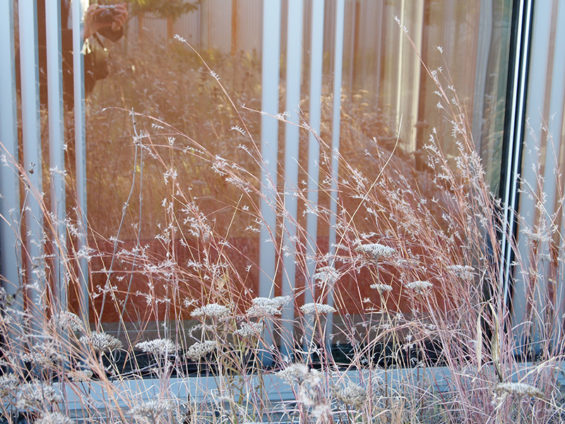
Two 80 sf hydraulically-isolated bioretention tree pits within the Meadow Roof sustain six Sweet Bay Magnolias in a 50-inch deep profile. These small biorentention tree pits pre-treat runoff from an approximately 3,500 sf non-greened upper roof. This upper roof runoff is completely isolated from the rest of the water managed by the Meadow Roof and conveyed directly to the bioretention cells in the tree pits, where manifolds control flow rates to prevent erosion and evenly distribute the water. Runoff from the groundscape and the isolated tree pits in Meadow Roof is diverted to a collection tank prior to entering the underground detention system. The collected water is reused to irrigate the ground-level landscapes. We believe that this building represents the first instance in the United States of the integration of hydraulically-independent conventional bioretention cells into an extensive green roof.
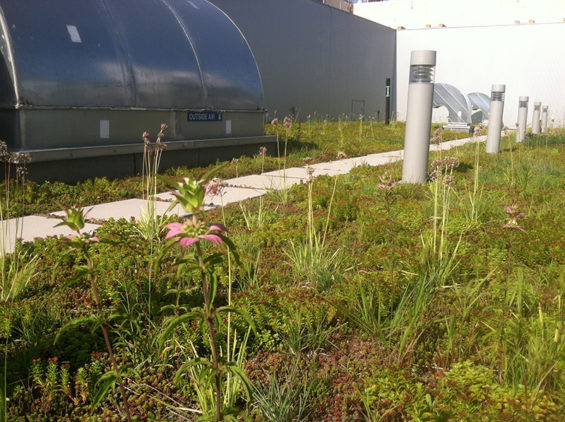
The foundation growth media layer is the primary zone of treatment for the runoff from impervious tributary areas. This is where the plant, bacteria, and fungi live and the concept of this design treatment is that of trickling filter, where loading rate, even water distribution, and a healthy biological community are the important factors in providing effective water treatment.
The green roofs are warranted for performance and plant coverage for a period of twenty years. The facility was awarded LEED Gold by the USGBC.
Krisha P. Singh Center for Nanotechnology
Client |University of Pennsylvania
Location: Philadelphia, PA
Design Firm | Roofmeadow (Green Roof Provider, Green Roof Design Consultant, Stewardship)
Architect | WEISS/MANFREDI
Civil Engineer | Stantac Consulting
Contractors | G.R.A.S.S. (Green Roof constructions and Maintenance)
Image Credits | Peg Woolsey or Roofmeadow

